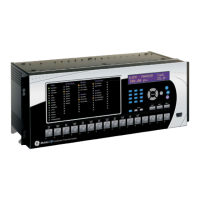5-202 T35 TRANSFORMER PROTECTION SYSTEM – INSTRUCTION MANUAL
GROUPED ELEMENTS CHAPTER 5: SETTINGS
5
PERCENT DIFFERENTIAL SLOPE 1 — Defines the percentage bias for the restraining currents below the lower breakpoint
(BREAK 1). This setting determines the sensitivity of the relay for low current internal faults. The setting must be set high
enough to cope with the spurious differential current resulting from inaccuracy of the CTs operating in their linear mode,
that is, in load conditions and during distant external faults.
PERCENT DIFFERENTIAL BREAK 1 — Defines the lower breakpoint of the dual-slope differential operating characteristic. This
setting needs to be set above the maximum load current and can be moved to the AC current under which all the CTs are
guaranteed to transform without saturation. This includes the effect of DC components and/or residual magnetism. The
latter can be as high as 80% of the nominal flux, effectively reducing the CT capabilities by the factor of five. When
adjusting this setting, it must be kept in mind that the restraining signal is created as the maximum of all the input currents.
PERCENT DIFFERENTIAL BREAK 2 — Defines the higher breakpoint of the dual-slope operating characteristic. Set BREAK 2
setting below the fault current that is likely to saturate the weakest CT feeding the relay. When adjusting this setting, keep
in mind that the restraining signal is created as the maximum of all the input currents.
PERCENT DIFFERENTIAL SLOPE 2 — Defines the percentage bias for the restraining currents above the higher breakpoint
(BREAK 2). This setting affects stability of the relay for heavy external faults. Traditionally, the value chosen for this setting
needs to be high enough to accommodate the spurious differential current resulting from saturation of the CTs during
heavy external faults. This requirement can be considerably relaxed in favor of sensitivity and speed of operation as the
relay detects CT saturation and upon detection applies the directional principle to prevent maloperation. When adjusting
this setting, keep in mind that the restraining signal is created as the maximum of all the input currents.
INRUSH INHIBIT FUNCTION — This setting provides a choice for 2nd harmonic differential protection blocking during
magnetizing inrush conditions. Two choices are available: “Adapt. 2nd” – adaptive 2nd harmonic, and “Trad. 2nd” –
traditional 2nd harmonic blocking. The adaptive 2nd harmonic restraint responds to magnitudes and phase angles of the
2nd harmonic and the fundamental frequency component. The traditional 2nd harmonic restraint responds to the ratio of
magnitudes of the 2nd harmonic and fundamental frequency components. If low second harmonic ratios during
magnetizing inrush conditions are not expected, set the relay to a traditional way of restraining.
INRUSH INHIBIT MODE — This setting specifies mode of blocking on magnetizing inrush conditions. Modern transformers
can produce small 2nd harmonic ratios during inrush conditions. This can result in undesired tripping of the protected
transformer. Reducing the 2nd harmonic inhibit threshold can jeopardize dependability and speed of protection. The 2nd
harmonic ratio, if low, causes problems in one phase only. This can be utilized as a means to ensure security by applying
cross-phase blocking rather than lowering the inrush inhibit threshold.
If set to “Per phase,” the relay performs inrush inhibit individually in each phase. If used on modern transformers, combine
this setting with adaptive 2nd harmonic function.
If set to “2-out-of-3,” the relay checks 2nd harmonic level in all three phases individually. If any two phases establish a
blocking condition, the remaining phase is restrained automatically. Note that in this mode, the "2-out-of-3" logic is used
only if all three phases of differential currents exceed the hardcoded cutoff level of 0.04 pu, otherwise, "1-out-of-3" logic is
used.
If set to “Average,” the relay first calculates the average 2nd harmonic ratio, then applies the inrush threshold to the
calculated average. This mode works only in conjunction with the traditional 2nd harmonic function.
If set to "1-out-of-3," the relay checks 2nd harmonic level in all three phases individually. If any phase establishes a
blocking condition, differential protection in all three phases are blocked. This mode is also known as "cross-blocking"
method.
INRUSH INHIBIT LEVEL — Specifies the level of 2nd harmonic component in the transformer magnetizing inrush current
above which the percent differential element is inhibited from operating. The value of the
INRUSH INHIBIT MODE setting
must be taken into account when programming this value. The
INRUSH INHIBIT LEVEL is set typically to 20%.
OVEREXCITATION INHIBIT MODE — An overexcitation condition resulting from an increased volts/hertz ratio poses a danger
to the protected transformer, hence the volts/hertz protection. A given transformer can, however, tolerate an overfluxing
condition for a limited time, as the danger is associated with thermal processes in the core. Instantaneous tripping of the
transformer from the differential protection is not desirable. The relay uses a traditional 5th harmonic ratio for inhibiting its
differential function during overexcitation conditions.
OVEREXCITATION INHIBIT LEVEL — This setting is provided to block the differential protection during overexcitation. When the
5th harmonic level exceeds the specified setting (5th harmonic ratio) the differential element is blocked. The overexcitation
inhibit works on a per-phase basis.

